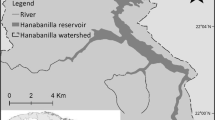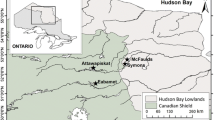Abstract
Salto Grande is a large South American reservoir on the border between Uruguay and Argentina that was impounded in 1979 and experiences recurrent, massive cyanobacteria blooms. A water-monitoring program was initiated 20 years after the dam was built, hence the causes and onset of cyanobacteria blooms remain poorly known. We collected two sediment cores from the old river channel in the reservoir (z = 17 m) and used physical, chemical and biological variables in the sediments, along with existing limnological data, to explore the history of cyanobacteria in the sub-tropical water body. Cyanobacteria fossil pigments were present at low concentrations during the first 24 years after impoundment, but more than doubled thereafter. Phytoplankton abundance tracked shifts in cyanobacteria pigment concentration, indicating an overall increase in all primary producers. Several sediment variables indicate a decline in water quality after 2003, such as increases in the number of photosynthetic sulfur bacteria and a reduction in sediment magnetic susceptibility. Akinetes (dormant cyanobacteria cells, Order Nostocales) in recent reservoir deposits were abundant and five species germinated under laboratory conditions, underscoring the ability of akinetes to initiate cyanobacteria blooms. The germinated assemblage reflected closely the composition of cyanobacteria blooms in the reservoir. Recorded increases in air temperature and decreases in wind speed, together with other variables (e.g. nutrients), can promote the large, recurrent cyanobacteria blooms. Invasion of the bivalve Limnoperna fortunei apparently promoted cyanobacteria blooms by preferential feeding on other phytoplankton taxa, and perhaps by altering nutrient concentrations and ratios. This work highlights the potential for using multiple variables in sediment cores from large reservoirs to better understand the responses of biota to multiple environmental stressors.







Similar content being viewed by others
References
Amé MV, Diaz MD, Wunderlin DA (2003) Occurrence of toxic cyanobacterial blooms in San Roque reservoir (Córdoba, Argentina): a field and chemometric study. Environ Toxicol 18:192–201
Appleby PG (2001) Chronostratigraphic techniques in recent sediments. In: Last WM, Smol JP (eds) Tracking environmental change using lake sediments, vol 1. Basin analysis, coring, and chronological techniques. Kluwer Academic Publishers, Dordrecht, pp 171–203
Appleby PG, Oldfield F (1983) The assessment of 210Pb from sites with varying sediment accumulation rates. Hydrobiologia 103:29–35
Bennett KD (1996) Determination of the number of zones in a biostratigraphical sequence. New Phytol 132:155–170
Berón LE (1990) Features of the limnological behavior of Salto Grande’s reservoir (Argentina–Uruguay). Ecol Model 52:87–102
Birks HJB, Gordon AD (1985) Numerical methods in quaternary pollen analysis. Academic Press, London
Boltovskoy D, Correa N, Cataldo D, Sylvester F (2006) Dispersion and ecological impact of the invasive freshwater bivalve Limnoperna fortunei in the Río de la Plata watershed and beyond. Biol Invasions 8:947–963
Boltovskoy D, Correa N, Bordet F, Leites V, Cataldo D (2013) Toxic Microcystis (cyanobacteria) inhibit recruitment of the bloom-enhancing invasive bivalve Limnoperna fortunei. Freshw Biol 58:1968–1981
Bordet F, Fontanarrosa MS, O’Farrell I (2017) Influence of light and mixing regime on bloom-forming phytoplankton in a subtropical reservoir. River Res Appl 33:1315–1326
Carpenter SR, Christensen DL, Cole JJ, Cottingham KL, He X, Hodgson JR, Kitchell JF, Knight SE, Pace ML, Post DM, Schindler DE, Voichick N (1995) Biological control of eutrophication in lakes. Environ Sci Technol 29:784–786
Cataldo D, Vinocur A, O′Farrell I, Paolucci E, Leites V, Boltovskoy D (2012) The introduced bivalve Limnoperna fortunei boosts Microcystis growth in Salto Grande reservoir (Argentina): evidence from mesocosm experiments. Hydrobiologia 680:25–38
Chalar G (2006) Eutrophication dynamics on different temporary scales: Salto Grande reservoir (Argentina–Uruguay). In: Tundisi JG, Matsumura-Tundisi T, Sidagis C (eds) Eutrophication in South America: causes, consequences and technologies for management and control. International Institute of Ecology, São Carlos, pp 87–101
Chalar G (2009) The use of phytoplankton patterns of diversity for algal bloom management. Limnologica 39:200–208
Cirés S, Wörmer L, Agha R, Quesada A (2013) Overwintering populations of Anabaena, Aphanizomenon and Microcystis as potential inocula for summer blooms. J Plankton Res 35:1254–1266
de Tezanos PP, Litchman E (2010a) Interactive effects of N: P ratios and light on nitrogen-fixer abundance. Oikos 119:567–575
de Tezanos PP, Litchman E (2010b) Eco-physiological responses of nitrogen-fixing cyanobacteria to light. Hydrobiologia 639:63–68
Dearing JA (2013) Why future Earth needs lake sediment studies. J Paleolimnol 49:537–545
Drozd A, Arturi M (2017) Dinámica de los cambios en los patrones de coberturas/usos del suelo, entre 1985 y 2015, Federación, Entre Ríos: Patrón de cambios en las superficies forestadas y otras coberturas/usos y su relación a órdenes de suelos. Informe elaborado desde el Laboratorio de Investigación de Sistemas Ecológicos y Ambientales (LISEA) de la Universidad Nacional de la Plata (UNLP) para la Comisión Técnica Mixta Salto Grande (CTM), Argentina
Drozd A, de Tezanos PP, Fernandez V, Bazzalo M, Bordet F, Ibaniez G (2019) Hyperspectral remote sensing monitoring of cyanobacteria blooms from the Salto Grande reservoir: high and medium spatial resolution satellite algorithms simulation. Mar Freshw Res. https://doi.org/10.1071/MF18429
Frau D, Rojas Molina F, Devercelli M, José de Paggi S (2013) The effect of an invading filter-feeding bivalve on a phytoplankton assemblage in the Paraná system: a mesocosm experiment. Mar Behav Physiol 45:303–316
Gilbert RO (1987) Statistical methods for environmental pollution monitoring. Van Nostrand Reinhold, New York
Guilizzoni P (2012) Palaeolimnology: an introduction. In: Gopal B (ed) Limnology of rivers and lakes. Encyclopedia of Life Support Systems (EOLSS), UNESCO, EOLSS Publishers, Oxford
Guillard RRL (1975) Culture of phytoplankton for feeding marine invertebrates. In: Smith WL, Chantey MH (eds) Culture of marine invertebrate animals. Plenum Publishers, New York, pp 29–60
Heiri O, Lotter AF, Lemcke G (2001) Loss on ignition as a method for estimating organic and carbonate content in sediments: reproducibility and comparability of results. J Paleolimnol 25:101–110
Hellweger FL, Kravchuk E, Novotny V, Gladyshev M (2008) Agent-based modeling of the complex life cycle of a cyanobacterium (Anabaena) in a shallow reservoir. Limnol Oceanogr 53:1227–1241
Huisman JM, Matthijs HCP, Visser PM (2005) Harmful cyanobacteria. Springer aquatic ecology, series 3. Springer, Dordrecht
Ibelings BW, Havens KE (2008) Cyanobacterial toxins: a qualitative meta-analysis of concentrations, dosage and effects in freshwater, estuarine and marine biota. In: Hudnell HK (ed) Cyanobacterial harmful algal blooms: state of the science and research needs. advances in experimental medicine and biology. Springer, New York, pp 675–732
IPCC (2014) Cambio climático 2014: Informe de síntesis. Contribución de los Grupos de Trabajo I, II y III al Quinto Informe de Evaluación del Grupo Intergubernamental de Expertos sobre el Cambio Climático. IPCC, Ginebra, Suiza
Joung SH, Oh HM, Ko SR, Ahn CY (2011) Correlation between environmental FACTORS and toxic and non-toxic Microcystis dynamics during bloom in Daechung Reservoir, Korea. Harmful Algae 10:188–193
Kalff J (2002) Limnology: inland waters ecosystems. Prentice Hall Publishers, Upper Saddle River, NJ
Kawamura N, Oda H, Ikehara K, Yamazaki T, Shioi K, Taga S, Hatakeyama S, Torii M (2007) Diagenetic effect on magnetic properties of marine core sediments from the southern Okhotsk Sea. Earth Planets Space 59:83–93
Kowalewski GA, Kornijów R, McGowan S, Kaczorowska A, Bałaga K, Namiotko T, Gąsiorowski M, Wasiłowska A (2016) Disentangling natural and anthropogenic drivers of changes in a shallow lake using palaeolimnology and historical archives. Hydrobiologia 767:301–320
Lami A, Guilizzoni P, Marchetto A (2000) High resolution analysis of fossil pigments, carbon, nitrogen and sulphur in the sediment of eight European Alpine lakes: the MOLAR project. J Limnol 59:15–28
Lami A, Musazzi S, Marchetto A, Buchaca T, Kernan M, Jeppesen E, Guilizzoni P (2009) Sedimentary pigments in 308 alpine lakes and their relation to environmental gradients. Adv Limnol 62:217–238
Leavitt PR, Sanford PR, Carpenter SR, Kitchell JF, Benkowski D (1993) Annual fossil records of food-web manipulation. In: Carpenter SR, Kitchell JF (eds) The trophic cascade in lakes. Cambridge University Press, Cambridge, pp 278–309
Legrand B, Le Jeune AH, Colombet J, Thouvenot A, Latour D (2017) Akinetes may be representative of past nostocalean blooms: a case study of their benthic spatiotemporal distribution and potential for germination in a eutrophic lake. Appl Environ Microbiol 83:1–14
Li Z, Yu J, Yang M, Zhang J, Burch MD, Han W (2010) Cyanobacterial population and harmful metabolites dynamics during a bloom in Yanghe Reservoir, North China. Harmful Algae 9:481–488
MacKenzie AB, Hardie SML, Farmer JG, Eades LJ, Pulford ID (2011) Analytical and sampling constrains in 210Pb dating. Sci Total Environ 409:1298–1304
McCall PI, Robbins JA, Matisoff G (1984) 137Cs and 210Pb transport and geochronologies in urbanized reservoirs with rapidly increasing sedimentation rates. Chem Geol 44:33–66
McGowan S (2013) Pigment studies. In: Elias SA (ed) Encyclopedia of quaternary science, 2nd edn. Elsevier, Amsterdam, pp 326–338
Merel S, Walker D, Chicana R, Snyder S, Baurès E, Thomas O (2013) State of knowledge and concerns on cyanobacterial blooms and cyanotoxins. Environ Int 59:303–327
O’Farrell I, Izaguirre I (2014) Phytoplankton of the middle and lower stretches of the Uruguay River. Adv Limnol 65:113–126
O’Farrell I, Bordet F, Chaparro G (2012) Bloom forming cyanobacterial complexes co-occurring in a subtropical large reservoir: validation of dominant eco-strategies. Hydrobiologia 698:175–190
O’Neil JM, Davis TW, Burford MA, Gobler CJ (2012) The rise of harmful cyanobacteria blooms: the potential roles of eutrophication and climate change. Harmful Algae 14:313–334
Paerl HW (2017) Controlling harmful cyanobacterial blooms in a climatically more extreme world: management options and research needs. J Plankton Res 39:763–771
Paerl HW, Paul VJ (2012) Climate change: links to global expansion of harmful cyanobacteria. Water Res 46:1349–1363
Pennington W, Cambray RS, Eakins JD, Harkness DD (1976) Radionuclide dating of the recent sediments of Blelham Tarn. Freshw Biol 6:317–331
Rahman AKM, Al Bakri D, Ford P, Church T (2005) Limnological characteristics, eutrophication and cyanobacterial blooms in an inland reservoir, Australia. Lake Reserv Res Manag 10:211–220
Riedinger-Whitmore MA, Whitmore TJ, Smoak JM, Brenner M, Moore A, Curtis J, Schelske CL (2005) Cyanobacterial proliferation is a recent response to eutrophication in many Florida lakes: a paleolimnological assessment. Lake Reserv Manag 21:423–435
Rojas Molina F, Paggi JC, Devercelli M (2010) Zooplanktophagy in the natural diet and selectivity of the invasive mollusk Limnoperna fortunei. Biol Inv 12:1647–1659
Taranu ZE, Gregory-Eaves I, Leavitt PR, Bunting L, Buchaca T, Catalan J, Domaizon I, Guilizzoni P, Lami A, McGowan S, Moorhouse H, Morabito G, Pick FR, Stevenson MA, Thompson PL, Vinebrooke RD (2015) Acceleration of cyanobacterial dominance in north temperate-subarctic lakes during the Anthropocene. Ecol Lett 18:375–384
Te SH, Gin KYH (2011) The dynamics of cyanobacteria and microcystin production in a tropical reservoir of Singapore. Harmful Algae 10:319–329
Thompson R, Oldfield F (1986) Environmental magnetism. Allen & Unwin Ltd., London
Wagner C, Adrian R (2009) Quantifying the effects of climate change. Limnol Oceanogr 54:2460–2468
Wengrat S, Padial AA, Jeppesen E, Davidson TA, Fontana L, Costa-Böddeker S, Bicudo DC (2018) Paleolimnological records reveal biotic homogenization driven by eutrophication in tropical reservoirs. J Paleolimnol 60:299–309
Williamson CE, Saros JE, Warwick FV, Smol JP (2009) Lakes and reservoirs as sentinels, integrators, and regulators of climate change. Limnol Oceanogr 54:2273–2282
Znachor P, Jurczak T, Komárková J, Jezberová J, Mankiewicz J, Kaštovská K, Zapomělová E (2006) Summer changes in cyanobacterial bloom composition and microcystin concentration in eutrophic Czech reservoirs. Environ Toxicol 21:236–243
Acknowledgements
DG acknowledges a grant from the Comisión Administradora del Río Uruguay (CARU) and PTP acknowledges funding from PIP 0236 (CONICET). We are grateful to the Comisión Técnica Mixta de Salto Grande for providing: (1) financial assistance to date the sediments, (2) the boat for sampling, and (3) historical data on water flow and water depth. We thank the Instituto Nacional de Tecnología Agropecuaria (INTA) for providing historical data on rainfall, wind speed and air temperature. We are grateful to Allyson Hutchens for language revision. We thank the Editor and two anonymous reviewers for their feedback and comments, which improved our work.
Author information
Authors and Affiliations
Corresponding author
Additional information
Publisher's Note
Springer Nature remains neutral with regard to jurisdictional claims in published maps and institutional affiliations.
Rights and permissions
About this article
Cite this article
Gangi, D., Plastani, M.S., Laprida, C. et al. Recent cyanobacteria abundance in a large sub-tropical reservoir inferred from analysis of sediment cores. J Paleolimnol 63, 195–209 (2020). https://doi.org/10.1007/s10933-020-00110-8
Received:
Accepted:
Published:
Issue Date:
DOI: https://doi.org/10.1007/s10933-020-00110-8




